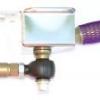wow, that's detailed explainations !
indeed the lotus brace is not THE solution
but I'm also staring at yours... that's what can be called "complicate engineering"... complicate for low gain, if not nothing
If you don't transfer the loads to a not working side of the subframe, as Lotus does with the 3rd clamping point (that's really not optimum but with the constraint of not changing the subframe design)... you simply balance the loads from 1 toe link to the other. Without any local load reduction around, which would have helped in the prevention of the subframe cracking that has already been seen. furthermore you will not avoid bending of the subframe (same effect) because of the rod ends supporting no torque. single (or better : double) shear pivot brace (instead of double shear rod) would have helped the subframe, taking for itself some of the torque created by the lever corresponding to the distance from the toe link rod center to the subframe
with this setup you gain :
-some strength on the bolt that holds the toe-link on the chassis, thanks to the stiffness of the double-shear bracket & the brace bracket tighten on it
-extra weight
the brace will remain approximately idle as, when cornering, it will only be loaded by the (small) difference of lateral forces on the 2 toe links. that was not the intent
to have the brace useful, one must find a way to clamp it firmly to the subframe, and not in an area loaded by the toe links...
I'm working to find a solution, but on the VX220 nothing comes easily (maybe somewhere around the engine mount)
Possibly it was too detailed

OK, normally the toe link is only transferring the forces to the subframe. This is fine as long as everything is a strong as it should be.
But I am led to believe though that this is not the case, especially when high grip tyres are used there are two problems ….
The first is that the ball joints are not strong enough in single shear and sometimes fail as they do regularly on the Elise.
The second problem which is Toyo Elise and VX specific is that the subframe flexes too much on the outer side when cornering causing changes in Geo and possibly even causing stress fractures as you mentioned.
The solution to the first problem is to replace the ball joint with a quality bearing and also to take the opportunity to double shear the inner mount.
The second problem is to support the subframe in some way without re-designing it as you mentioned. The advantage of the brace is you share any loads that come through the toe links to the subframe across both sides of the subframe effectively halving the load. Remember, the high forces are only generated in the outside wheel where a significant proportion of the weight has transferred.
Not quite true of course as the effect on the inner wheel which is being dragged outward is to pull on the toe-link not compress it, so both forces are acting in the same direction though the forces involved here are light compared to the outer so the overall effect is to share the high load on the outer toe-link across both arms of the subframe.
This is how the brace kit functions.
The total load is not the problem, the problem is the individual load induced by cornering on the outside tyre.
So you are correct, the load is only “balanced†but across the subframe rather than the links, allowing both arms to take the force simultaneously. For the “non- working†part of the subframe the brace uses the other arm as it is not working very hard at the same moment the other side is.
This causes a major reduction on the amount of force each arm of the subframe has to endure in turn as no single arm has to take the full cornering force anymore. This will lead to a substantial reduction in subframe distortion and a reduction in stress induced fatigue.
It will also increase the rigidity of the subframe in that plane helping to keep the geometry correct under load. Further restriction in one plane will often cause a restriction in another as the component cannot twist etc until it has moved significantly.
The second part of your post I cannot quite understand enough to comment I’m afraid.
Though I think it is based on the assumption the total force is the issue?
Are you saying the force generated on the inside wheel is also too great for the frame?
If there is an option to locate the brace to an additional location on the VX frame I cannot see any reason why this could not be investigated, though you need to be very careful as you will be aware in case you cause the area to become too rigid which creates it’s own bunch of problems and may cause stress cracking elsewhere.
The VX subframe is not the same as the Elise one though similar; how the differences are reflected in stress pattern across the chassis and subframe I have no idea.
Unless you wish to spend a lot of time and money doing a thorough stress analysis of the subframe and suspension system or really know what you are doing and prepared to take the consequences may I humbly suggest it is best left as it is?
If your experience and knowledge is such that you can modify it safely then that is a great bonus and I am sure many here will wish be involved or at least share the result with you.
The gains from the brace are substantial, relatively safe, simple, easy to fit, and even good value.
BUT the choice, as always is yours
The extra weight mentioned by the way including the rod ends, boots, brace brackets, collets and bolts is less than 1KG! and will support over 3 tonnes, substantially more than forces generated by the suspension, impact notwithstanding.
















